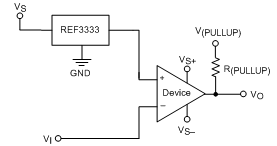SLOSE29B November 2018 – August 2024 TLV1704-SEP
PRODUCTION DATA
- 1
- 1 Features
- 2 Applications
- 3 Description
- 4 Pin Configuration and Functions
- 5 Specifications
- 6 Detailed Description
- 7 Application and Implementation
- 8 Device and Documentation Support
- 9 Revision History
- 10Mechanical, Packaging, and Orderable Information
Package Options
Mechanical Data (Package|Pins)
- PW|14
Thermal pad, mechanical data (Package|Pins)
Orderable Information
6.4.1 Setting Reference Voltage
Using a stable reference is important when setting the transition point for the TLV1704-SEP device. The REF3333, as shown in Figure 6-2, provides a 3.3V reference voltage with low drift and only 3.9μA of quiescent current.
 Figure 6-2 Reference Voltage for the TLV1704-SEP
Figure 6-2 Reference Voltage for the TLV1704-SEP